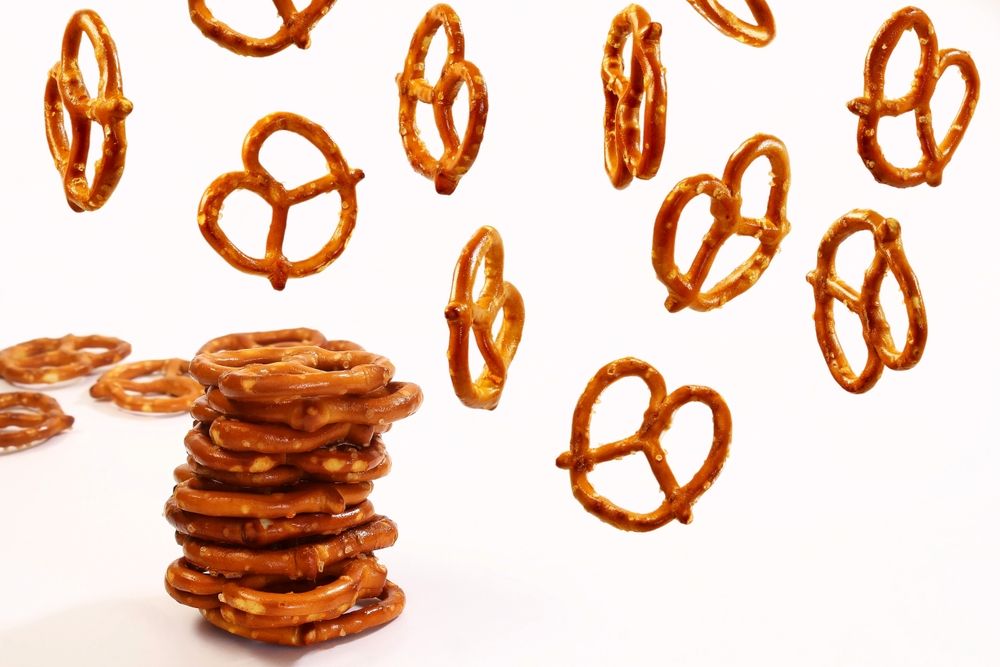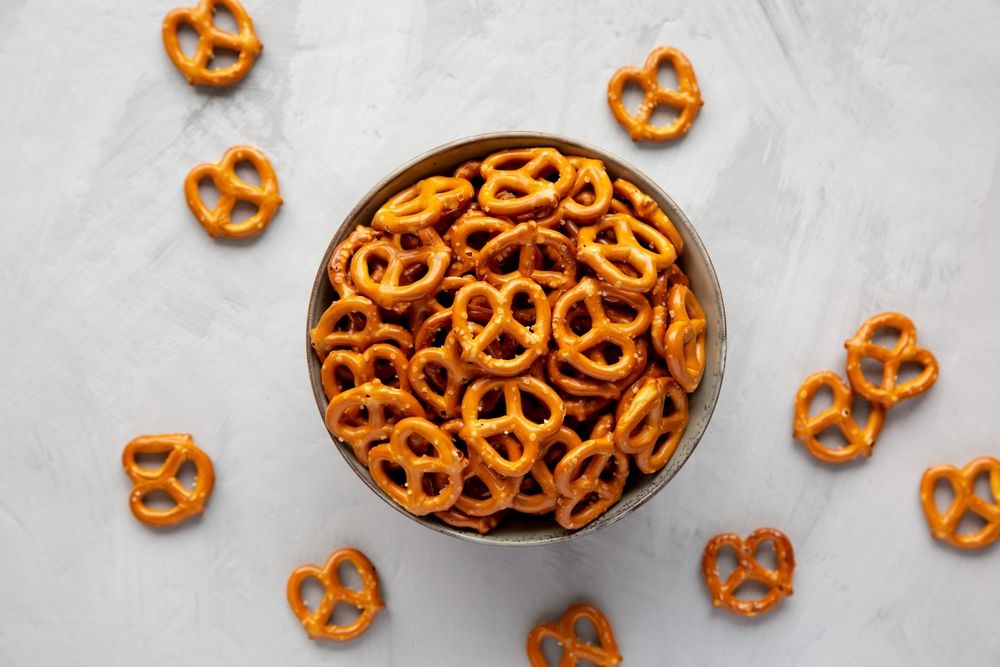When you're craving something salty, pretzels can really hit the spot with their satisfying crunch and versatility. Many view pretzels as a healthier alternative to high-fat snacks like potato chips. But are pretzels actually healthy?
As a dietitian, I can confirm that pretzels can be included in a healthy diet. In this article, we'll explore their benefits and drawbacks, and provide tips on how to enjoy them, even if you have specific health concerns.
What Are Pretzels Made Of?

Pretzels are shiny, brown, flour-based yeast snacks twisted into knots before baking. They come in various flavors and textures, with some filled with peanut butter or cheese, others dipped in chocolate, or topped with different coatings. The basic ingredients include flour, yeast, salt, butter or shortening, sugar, and water. Unlike fermented bread, pretzels are meant to be dense, so they aren't left to rise.
Pretzel-Making Process
The process of making pretzels involves several key steps. Commercial pretzels are dipped in a warm lye bath for 10-25 seconds before baking. This sodium hydroxide solution gives pretzels their characteristic color and flavor. Homemade pretzels can be boiled for 20-30 seconds before baking. After this, they are sprinkled with salt and baked for 12-15 minutes.
Nutritional Profile of Pretzels
Pretzels are a great source of carbohydrates and are low in fat; however, they are also low in protein.
Nutritional Information for White Pretzels (per 60 grams/~10 pretzel twists):
- Calories: 230
- Fat: 1 g (Saturated fat: 0 g)
- Sodium: 744 mg
- Carbohydrates: 48 g (Fiber: 2 g, Sugar: 1 g)
- Protein: 6 g
Nutritional Information for Wheat Pretzels (per 57 grams/~10 pretzel twists):
- Calories: 206
- Fat: 1 g (Saturated fat: 0 g)
- Sodium: 116 mg
- Carbohydrates: 46 g (Fiber: 4 g, Sugar: 1 g)
- Protein: 6 g
The nutritional value of pretzels can vary depending on their ingredients and preparation method. Pretzels made with enriched wheat flour contain more fiber and nutrients, such as iron, B vitamins (thiamin, riboflavin, and niacin), and calcium, compared to those made with white flour. Filled or coated pretzels will have different calorie and fat contents.
Health Benefits of Pretzels

Increased Energy Levels
Carbohydrates are the body's and brain's preferred fuel source. Pretzels, being simple carbohydrates, digest quickly, providing an almost immediate energy boost. When you consume carbs, your body breaks them down into glucose, which raises blood sugar levels and triggers the pancreas to release insulin. Insulin helps transport glucose from the bloodstream to cells for energy. Without this rise in blood sugar, you wouldn't be able to obtain the nutrients and energy needed from your food.
Improved Fiber Intake
A 2-ounce (57-gram) serving of wheat pretzels provides 4 grams of fiber, which is over 10% of the daily recommended intake of 25-30 grams. Choosing a fiber-rich dip like hummus or guacamole adds another 2 grams of fiber per 2-tablespoon serving.
Fiber is the indigestible portion of plant foods and carbohydrates. Unlike simple carbs, fiber-rich whole grains, fruits, and vegetables cause a slower rise in blood sugar, providing a more stable release of energy and nutrients. This is because fiber takes longer to move through the digestive tract, helping you feel full and satisfied longer, which can prevent overeating.
Meeting Vitamin and Mineral Needs
Pretzels made with enriched wheat flour may contain more iron, B vitamins, and calcium compared to those made with regular white flour. During the milling process, vitamins and minerals are often stripped from the grain, but enriched flour restores these nutrients to their original levels. This can help fill nutritional gaps when dietary sources are lacking.
Since 1996, the FDA has required folic acid enrichment in refined flours, making wheat pretzels a good source of folate, which is essential during pregnancy for preventing neural tube defects.
Potential Drawbacks of Pretzels

Potential Drawbacks of Eating Pretzels
While pretzels have some benefits, there are also drawbacks to consider. Pretzels can be high in sodium, which is particularly concerning for those with a history of cardiovascular disease. They are not inherently gluten-free, posing a risk for individuals with a gluten allergy or celiac disease. Additionally, their high carbohydrate content, coupled with very little protein, fat, and fiber, means that people with type 2 diabetes or insulin resistance should exercise caution.
Excess Sodium Consumption
Pretzels' salty nature is a significant part of their appeal. However, this can be problematic for individuals with a history of cardiovascular disease or hypertension. One 10-twist serving of pretzels contains 744 milligrams of sodium, which is 32% of the recommended daily limit of 2,300 milligrams. For those with cardiovascular disease or hypertension, the recommended limit is 1,500 milligrams per day. Studies have shown that reducing daily sodium intake by 1,000 milligrams can lower cardiovascular risk by 6%.
While it's not necessary to avoid sodium entirely, opting for low-sodium or no-salt-added pretzels is a better choice for those who need to limit their sodium intake. Sodium is an essential electrolyte, and eliminating it completely can cause issues with fluid balance and homeostasis. If you are considering a low-sodium diet, consult your doctor to determine if it is a healthy choice for you.
Potential for High Blood Sugar Spikes
Pretzels have a high glycemic index (GI), meaning they are quickly digested and absorbed into the bloodstream, causing a rapid spike in blood sugar levels. This can be challenging for individuals with type 2 diabetes, pre-diabetes, or insulin resistance. A rapid increase in blood sugar can lead to a subsequent drastic drop, leaving you feeling sluggish and hungry shortly after. Frequent occurrences of high blood sugar spikes, if left untreated, can contribute to health issues such as heart disease, kidney problems, eye disease, and obesity.
Balancing Blood Sugar Levels
To mitigate these effects, pair pretzels with low glycemic index foods that are rich in dietary fiber and protein. This combination can help stabilize blood glucose levels. Instead of eating pretzels alone, consider pairing them with nuts, cheese, or your favorite dip. This can help flatten the blood glucose curve and maintain more stable energy levels.
Gluten Concerns
Pretzels are generally not gluten-free and can trigger adverse reactions in individuals with celiac disease or gluten sensitivity. When someone with celiac disease consumes gluten, their body mounts an inappropriate immune response, causing inflammation and damage to the small intestine. Symptoms can include lethargy, diarrhea, abdominal pain, vomiting, and constipation. People with these conditions should consult a doctor or dietitian for guidance on a gluten-free diet.
Are Pretzels Healthy?
Contrary to popular belief, pretzels can be part of a healthy diet. While pretzels made with white flour might pose concerns for those with heart disease, high blood sugar, insulin resistance, or celiac disease, you don't have to eliminate them completely. Traditional white flour pretzels are high in carbohydrates and low in nutritional value, but combining them with more nutritious foods can balance out their benefits and drawbacks. Choosing whole grain, enriched pretzels can add fiber, vitamins, and minerals like iron and B vitamins to your diet.
Tips for Choosing Healthy Pretzels
Today's food manufacturers are enhancing pretzels to make them healthier. When shopping for healthy pretzels, consider your health needs, flavor preferences, and the nutritional profile of the available products.
- Low-sodium: Look for products labeled as low-sodium or no-salt-added to avoid consuming too much sodium in one sitting.
- Gluten-free: If you have celiac disease or need to avoid gluten, choose gluten-free pretzels. Always read the ingredients list to ensure there's no hidden gluten.
- Whole-grain: Opt for whole-grain or whole-wheat pretzels for a better dose of fiber, vitamins, and minerals that help maintain a healthy body.
By making informed choices, you can enjoy pretzels as a tasty and nutritious snack.
How to Incorporate Pretzels into a Healthy Diet

Pair with Protein: Enjoy pretzels with protein-rich foods like hummus, nut butter, cheese, or yogurt. This helps balance their high carbohydrate content and provides longer-lasting energy.
Choose Whole Grain: Opt for whole grain or whole wheat pretzels to increase your intake of fiber, vitamins, and minerals, supporting overall health and digestion.
Watch the Sodium: Select low-sodium or no-salt-added pretzels to reduce your sodium intake, which is especially important for maintaining heart health.
Add Vegetables: Combine pretzels with fresh vegetables like carrot sticks, celery, or bell pepper strips. This adds extra nutrients and fiber to your snack.
Moderate Portions: Keep an eye on portion sizes to avoid consuming too many carbohydrates at once, which can spike blood sugar levels. Stick to a serving size and pair it with other healthy foods.
Gluten-Free Options: If you have celiac disease or gluten sensitivity, choose gluten-free pretzels. Ensure they are certified gluten-free to avoid any adverse reactions.
By following these tips, you can enjoy pretzels as a delicious and nutritious part of your balanced diet.
Fortunately, there are plenty of pretzel options to suit all taste preferences. Some of my favorites include Snack Factory Pretzel Crisps, which are perfect for dipping; FitJoy Grain-Free Pretzels, a great gluten-free option; and BeyondTwistz Pretzels, which offer 4 grams of fiber per serving.

